A Comparative Performance Investigation of Single- and Double-Nozzle Pulse Mode Minimum Quantity Lubrication Systems in Turning Super-Duplex Steel Using a Weighted Pugh Matrix Sustainable Approach
Abstract
1. Introduction
- Experimental performance comparison of single-nozzle pulse mode MQL and dual-nozzle pulse mode MQL in turning UNS S32750 super duplex stainless steel.
- Machinability evaluation of UNS S32750 super duplex steel by varying feed, depth of cut, and pulse time of MQL flow.
- Sustainability evaluation between single-nozzle and double-nozzle MQL pulse modes in turning UNS S32750 super duplex stainless steel.
2. Materials and Methods
3. Results and Discussions
3.1. Surface Quality Analysis
3.2. Tool-Flank Wear Analysis
3.3. Tool-Flank Temperature Analysis
3.4. Power Consumption Analysis
3.5. Material Removal Rate Analysis
4. Regression Modeling
4.1. Regression Equations for Single-Nozzle Results
4.2. Regression Equations for Double-Nozzle Results
5. Sustainability Assessment
6. Conclusions
- Double-nozzle MQL offered significant advantages over single-nozzle MQL systems by lowering Ra, VB, Pc, and Tf. The MRR is significantly improved with the use of the double nozzle. Considering the average results of nine experiments, in comparison to the single nozzle, Ra, VB, Tf, and Pc were found to be decreased by 11.16%, 21.24%, 7.07%, and 3.16% with the double nozzle, respectively, whereas MRR was found to be 18.37% higher with the double nozzle.
- In both cooling strategies, the lowest Ra was found as 0.68 μm with double-nozzle MQL. The recommended feed, pulse time and depth of cutting for machining super duplex steel is 0.08 mm/rev, 1 s and 0.1 mm. For both machining strategies, feed had the largest impact on Ra, while the depth of cut and pulse time also significantly altered the Ra.
- The common wear mechanisms such as abrasion, built-up edge, adhesion, and notch wear were detected in both cooling strategies. In the entire experiments, the lowest wear of 0.092 mm was achieved when double-nozzle MQL was operated with 1 s pulse time. The impact of pulse time for double-nozzle MQL was found to be highest (74.98%) among all variables.
- The tool-flank temperature under single-nozzle MQL was greatly affected by the feed rate, while the depth of cut was the most influencing term when machining was finished in double-nozzle MQL. In both cases, pulse time exhibited significance on tool-flank temperature with a contribution of 26.77% (single nozzle) and 37.85% (double nozzle).
- A marginal improvement in power consumption was noticed when machining was executed under the double nozzle. The pulse rate has negligible effects on power consumption, while the depth of cut exhibited the largest effect for both cases.
- The material removal rate was greatly improved in double-nozzle MQL-assisted turning. The consequence of depth of cutting as well as feed was found to be significant, while pulse time has insignificant effects on it.
- According to the Pugh matrix sustainable evaluation, the single nozzle earns a final score of +9, while the double nozzle receives a final score of +14. This score clearly shows that the double-nozzle MQL technique was superior to the single-nozzle MQL strategy in terms of sustainability.
Author Contributions
Funding
Institutional Review Board Statement
Informed Consent Statement
Data Availability Statement
Acknowledgments
Conflicts of Interest
References
- Renaudot, N.; Chauveau, E.; Mantel, M. Machinability of duplex stainless steels long products: How to deal with the sulphur way? Rev. Métallurgie 2011, 108, 245–257. [Google Scholar] [CrossRef]
- Philip, S.D.; Chandramohan, P.; Rajesh, P.K. Prediction of surface roughness in end milling operation of duplex stainless steel using response surface methodology. J. Eng. Sci. Technol. 2015, 10, 340–352. [Google Scholar]
- Alabdullah, M.; Polishetty, A.; Littlefair, G. Impacts of wear and geometry response of the cutting tool on machinability of super austenitic stainless steel. Int. J. Manuf. Eng. 2016, 2016, 7213148. [Google Scholar] [CrossRef]
- Patra, S.; Agrawal, A.; Mandal, A.; Podder, A.S. Characteristics and manufacturability of duplex stainless steel: A review. Trans. Indian Inst. Met. 2021, 74, 1089–1098. [Google Scholar] [CrossRef]
- Krolczyk, G.M.; Nieslony, P.; Legutko, S. Determination of tool life and research wear during duplex stainless steel turning. Arch. Civ. Mech. Eng. 2015, 15, 347–354. [Google Scholar] [CrossRef]
- Gowthaman, P.S.; Jeyakumar, S.; Saravanan, B.A. Machinability and tool wear mechanism of duplex stainless steel—A review. Mater. Today Proc. 2020, 26, 1423–1429. [Google Scholar] [CrossRef]
- Rajaguru, J.; Arunachalam, N. A comprehensive investigation on the effect of flood and MQL coolant on the machinability and stress corrosion cracking of super duplex stainless steel. J. Mater. Process. Technol. 2020, 276, 116417. [Google Scholar]
- Lee, P.-H.; Nam, J.S.; Li, C.; Lee, S.W. An experimental study on micro-grinding process with nanofluid minimum quantity lubrication (MQL). Int. J. Precis. Eng. Manuf. 2012, 13, 331–338. [Google Scholar] [CrossRef]
- Balasuadhakar, A.; Kumaran, S.T.; Ahmed, F. A review on the role of nanoparticles in MQL machining. Mater. Today Proc. 2023, 72, 2828–2832. [Google Scholar] [CrossRef]
- Sultana, N.; Dhar, N.R. A critical review on the progress of MQL in machining hardened steels. Adv. Mater. Process. 2022, 8, 3834–3858. [Google Scholar] [CrossRef]
- Duc, T.M.; Long, T.T.; Tuan, N.M. Performance Investigation of MQL Parameters Using Nano Cutting Fluids in Hard Milling. Fluids 2021, 6, 248. [Google Scholar] [CrossRef]
- Singh, G.; Pruncu, C.I.; Gupta, M.K.; Mia, M.; Khan, A.M.; Jamil, M.; Pimenov, D.Y.; Sen, B.; Sharma, V.S. Investigations of machining characteristics in the upgraded MQL-assisted turning of pure titanium alloys using evolutionary algorithms. Materials 2019, 12, 999. [Google Scholar] [CrossRef] [PubMed]
- Catherine, L.D.K.; Hamid, D.B.A. Experimental analysis of adjustable nozzle system in Machining of titanium grade-2. Adv. Nat. Appl. Sci. 2020, 14, 230. [Google Scholar]
- Gariani, S.; Shyha, I.; Inam, F.; Huo, D. Evaluation of a novel controlled cutting fluid impinging supply system when machining titanium alloys. Appl. Sci. 2017, 7, 560. [Google Scholar] [CrossRef]
- Mia, M.; Dhar, N.R. Effects of duplex jets high-pressure coolant on machining temperature and machinability of Ti-6Al-4V superalloy. J. Mater. Process. Technol. 2018, 252, 688–696. [Google Scholar] [CrossRef]
- Sohrabpoor, H.; Khanghah, S.P.; Teimouri, R. Investigation of lubricant condition and machining parameters while turning of AISI 4340. Int. J. Adv. Manuf. Technol. 2015, 76, 2099–2116. [Google Scholar] [CrossRef]
- Gupta, M.K.; Boy, M.; Korkmaz, M.E.; Yaşar, N. Measurement and analysis of machining induced tribological characteristics in dual jet minimum quantity lubrication assisted turning of duplex stainless steel. Measurement 2022, 187, 110353. [Google Scholar] [CrossRef]
- Mallick, R.; Kumar, R.; Panda, A.; Sahoo, A.K. Hard Turning Performance Investigation of AISI D2 Steel under a Dual Nozzle MQL Environment. Lubricants 2023, 11, 16. [Google Scholar] [CrossRef]
- Kechagias, J.D.; Aslani, K.E.; Founta, N.A.; Vaxevanidis, N.M.; Manolakos, D.E. A comparative investigation of taguchi and full factorial design for machinability prediction in turning of a titanium alloy. Measurement 2020, 151, 107213. [Google Scholar] [CrossRef]
- Jagatheesan, K.; Babu, K. Taguchi optimization of minimum quantity lubrication turning of AISI-4320 steel using biochar nanofluid. Biomass Convers. Biorefin. 2023, 13, 927–934. [Google Scholar] [CrossRef]
- Sarıkaya, M.; Güllü, A. Multi-response optimization of minimum quantity lubrication parameters using Taguchi-based grey relational analysis in turning of difficult-to-cut alloy Haynes 25. J. Clean. Prod. 2015, 15, 347–357. [Google Scholar] [CrossRef]
- Alaba, E.S.; Kazeem, R.A.; Adebayo, A.S.; Petinrin, M.O.; Ikumapayi, O.M.; Jen, T.C.; Akinlabi, E.T. Evaluation of palm kernel oil as cutting lubricant in turning AISI 1039 steel using Taguchi-grey relational analysis optimization technique. Adv. Ind. Manuf. Eng. 2023, 6, 100115. [Google Scholar] [CrossRef]
- Krolczyk, G.M.; Maruda, R.W.; Krolczyk, J.B.; Wojciechowski, S.; Mia, M.; Nieslony, P.; Budzik, G. Ecological trends in machining as a key factor in sustainable production—A review. J. Clean. Prod. 2019, 218, 601–615. [Google Scholar] [CrossRef]
- Moran, T.; MacDonald, R.; Zhang, H. A Dynamic Simulation Model for Understanding Sustainability of Machining Operation. Sustainability 2023, 15, 152. [Google Scholar] [CrossRef]
- Kumar, M.; Mani, M. Sustainability assessment in manufacturing: Perspectives, challenges, and solutions. In Sustainable Manufacturing; Elsevier: Amsterdam, The Netherlands, 2021; pp. 287–311. [Google Scholar]
- Davim, J.P. (Ed.) Sustainable Machining; Springer: Berlin/Heidelberg, Germany, 2017. [Google Scholar]
- Padhan, S.; Dash, L.; Behera, S.K.; Das, S.R. Modeling and optimization of power consumption for economic analysis, energy saving carbon footprint analysis, and sustainability assessment in finish hard turning under graphene nanoparticle–assisted Minimum quantity lubrication. Process Integr. Optim. Sustain. 2020, 4, 445–463. [Google Scholar] [CrossRef]
- Ross, N.S.; Mia, M.; Anwar, S.; Manimaran, G.; Saleh, M.; Ahmad, S. A hybrid approach of cooling lubrication for sustainable and optimized machining of Ni-based industrial alloy. J. Clean. Prod. 2021, 321, 128987. [Google Scholar] [CrossRef]
- Das, A.; Gupta, M.K.; Das, S.R.; Panda, A.; Patel, S.K.; Padhan, S. Hard turning of AISI D6 steel with recently developed HSN2-TiAlxN and conventional TiCN coated carbide tools: Comparative machinability investigation and sustainability assessment. J. Braz. Soc. Mech. Sci. Eng. 2022, 44, 138. [Google Scholar] [CrossRef]
- Panda, A.; Das, S.R.; Dhupal, D. Machinability investigation and sustainability assessment in FDHT with coated ceramic tool. Steel Compos. Struct. Int. J. 2020, 34, 681–698. [Google Scholar]
- Sen, B.; Mia, M.; Krolczyk, G.M.; Mandal, U.K.; Mondal, S.P. Eco-Friendly Cutting Fluids in Minimum Quantity Lubrication Assisted Machining: A Review on the Perception of Sustainable Manufacturing. Int. J. Precis. Eng. Manuf. Green Technol. 2021, 8, 249–280. [Google Scholar] [CrossRef]
- Özbek, O.; Saruhan, H. The effect of vibration and cutting zone temperature on surface roughness and tool wear in ecofriendly MQL turning of AISI D2. J. Mater. Res. Technol. 2020, 9, 2762–2772. [Google Scholar] [CrossRef]
- Yan, L.; Yuan, S.; Liu, Q. Influence of minimum quantity lubrication parameters on tool wear and surface roughness in milling of forged steel. Chin. J. Mech. Eng. 2012, 25, 419–429. [Google Scholar] [CrossRef]
- Kumar, A.; Singh, G.; Agarwal, V. Analysis and optimization of nozzle distance during turning of EN 31 steel using minimum quantity lubrication. Mater. Today Proc. 2022, 49, 1360–1366. [Google Scholar] [CrossRef]
- Parsi, P.K.; Kotha, R.S.; Routhu, T.; Pandey, S.; Dwivedy, M. Machinability evaluation of coated carbide inserts in turning of super-duplex stainless steel. SN Appl. Sci. 2020, 2, 1933. [Google Scholar] [CrossRef]
- Roy, S.; Kumar, R.; Sahoo, A.K.; Pandey, A.; Panda, A. Investigation on hard turning temperature under a novel pulsating MQL environment: An experimental and modelling approach. Mech. Ind. 2020, 21, 605. [Google Scholar] [CrossRef]
- Usca, Ü.A.; Uzun, M.; Kuntoğlu, M.; Sap, E.; Gupta, M.K. Investigations on tool wear, surface roughness, cutting temperature, and chip formation in machining of Cu-B-CrC composites. Int. J. Adv. Manuf. Technol. 2021, 116, 3011–3025. [Google Scholar] [CrossRef]
- Bhushan, R.K. Effect of tool wear on surface roughness in machining of AA7075/10 wt.% SiC composite. Compos. Part C 2022, 8, 100254. [Google Scholar] [CrossRef]
- Binali, R.; Demirpolat, H.; Kuntoğlu, M.; Sağlam, H. Machinability Investigations Based on Tool Wear, Surface Roughness, Cutting Temperature, Chip Morphology and Material Removal Rate during Dry and MQL-Assisted Milling of Nimax Mold Steel. Lubricants 2023, 11, 101. [Google Scholar] [CrossRef]
- Boubekri, N.; Shaikh, V. Minimum Quantity Lubrication (MQL) in machining: Benefits and drawbacks. J. Ind. Intell. Inf. 2015, 3, 205–209. [Google Scholar] [CrossRef]
- Dixit, U.S.; Sarma, D.K.; Davim, J.P. Machining with minimal cutting fluid. In Environmentally Friendly Machining; Springer: Boston, MA, USA, 2012; pp. 9–17. [Google Scholar]
- Karthik, M.S.; Raju, V.R.; Reddy, K.N.; Balashanmugam, N.; Sankar, M.R. Cutting parameters optimization for surface roughness during dry hard turning of EN 31 bearing steel using CBN insert. Mater. Today Proc. 2020, 26, 1119–1125. [Google Scholar] [CrossRef]
- Rajan, K.M.; Sahoo, A.K.; Routara, B.C.; Kumar, R. Investigation on surface roughness, tool wear and cutting power in MQL turning of bio-medical Ti-6Al-4V ELI alloy with sustainability. Proc. Inst. Mech. Eng. Part E J. Process Mech. Eng. 2022, 236, 1452–1466. [Google Scholar] [CrossRef]
- Kulshreshtha, M. Analysis of the Effect of Machining Parameters on Surface Roughness of EN 36 Nickel Steel. Int. J. Adv. Inf. Sci. Technol. 2013, 16, 1–7. [Google Scholar]
- Raykar, S.J.; D’Addon, D.M.; Kramar, D. Analysis of Surface Topology in Dry Machining of EN-8 Steel. Procedia Mater. Sci. 2014, 6, 931–938. [Google Scholar] [CrossRef][Green Version]
- Chinchanikar, S.; Choudhury, S.K. Machining of hardened steel—Experimental investigations, performance modeling and cooling techniques: A review. Int. J. Mach. Tools Manuf. 2015, 89, 95–109. [Google Scholar] [CrossRef]
- ISO 3685; Tool-Life Testing with Single-Point Turning Tools. International Standardization Organization: Geneva, Switzerland, 1993.
- Astakhov, V.P. Effects of the cutting feed, depth of cut, and workpiece (bore) diameter on the tool wear rate. Int. J. Adv. Manuf. Technol. 2006, 34, 631–640. [Google Scholar] [CrossRef]
- Singh, G.; Gupta, M.K.; Mia, M.; Sharma, V.S. Modeling and optimization of tool wear in MQL-assisted milling of Inconel 718 superalloy using evolutionary techniques. Int. J. Adv. Manuf. Technol. 2018, 97, 481–494. [Google Scholar] [CrossRef]
- Suresh, R.; Basavarajappa, S.; Samuel, G.L. Some studies on hard turning of AISI 4340 steel using multilayer coated carbide tool. Measurement 2012, 45, 1872–1884. [Google Scholar] [CrossRef]
- Mia, M.; Razi, M.H.; Ahmad, I.; Mostafa, R.; Rahman, S.M.; Ahmed, D.H.; Dhar, N.R. Effect of time-controlled MQL pulsing on surface roughness in hard turning by statistical analysis and artifificial neural network. Int. J. Adv. Manuf. Technol. 2017, 91, 3211–3223. [Google Scholar] [CrossRef]
- Hong, S.Y.; Ding, Y. Cooling approaches and cutting temperatures in cryogenic machining of Ti-6Al-4V. Int. J. Mach. Tools Manuf. 2001, 41, 1417–1437. [Google Scholar] [CrossRef]
- Kus, A.; Isik, Y.; Cakir, M.; Coşkun, S.; Özdemir, K. Thermocouple and Infrared Sensor-Based Measurement of Temperature Distribution in Metal Cutting. Sensors 2015, 15, 1274–1291. [Google Scholar] [CrossRef]
- Mahapatro, M.; Krishna, P.V. Influence of flow parameters in the dual nozzle CO2-based vortex tube cooling system during turning of Ti-6Al-4V. Proc. Inst. Mech. Eng. Part C J. Mech. Eng. Sci. 2022, 236, 4828–4842. [Google Scholar] [CrossRef]
- Bilga, P.S.; Singh, S.; Kumar, R. Optimization of energy consumption response parameters for turning operation using taguchi method. J. Clean. Prod. 2016, 137, 1406–1417. [Google Scholar] [CrossRef]
- Şahinoğlu, A.; Rafighi, M. Optimization of cutting parameters with respect to roughness for machining of hardened AISI 1040 steel. Mater. Test. 2020, 62, 85–95. [Google Scholar] [CrossRef]
- Şahinoğlu, A.; Rafighi, M.; Kumar, R. An investigation on cutting sound effect on power consumption and surface roughness in CBN tool-assisted hard turning. Proc. Inst. Mech. Eng. Part E J. Process Mech. Eng. 2022, 236, 1096–1108. [Google Scholar] [CrossRef]
- Valeraa, H.Y.; Bhavsara, S.N. Experimental Investigation of Surface Roughness and Power Consumption in Turning Operation of EN 31 Alloy Steel. Procedia Technol. 2014, 14, 528–534. [Google Scholar] [CrossRef]
- Abbas, A.T.; Gupta, M.K.; Soliman, M.S.; Mia, M.; Hegab, H.; Luqman, M.; Pimenov, D.Y. Sustainability assessment associated with surface roughness and power consumption characteristics in nanofluid MQL-assisted turning of AISI 1045 steel. Int. J. Adv. Manuf. Technol. 2019, 105, 1311–1327. [Google Scholar] [CrossRef]
- Sahinoglu, A.; Rafighi, M. Investigation of Tool Wear, Surface Roughness, Sound Intensity and Power Consumption During Hard Turning of AISI 4140 using Multilayer-Coated Carbide Inserts. J. Eng. Res. 2021, 9, 377–395. [Google Scholar] [CrossRef]
- Kosky, P.; Balmer, R.; Keat, W.; Wise, G. Manufacturing Engineering. In Exploring Engineering; Academic Press: Cambridge, MA, USA, 2013; pp. 205–235. [Google Scholar]
- Deepak, D.; Rajendra, B. Studies on material removal rate of Al6061 while turning with coolant and without coolant using taguchi method. Int. J. Res. Eng. Technol. 2015, 4, 75–78. [Google Scholar]
- Bagawade, A.D.; Ramdasi, P.G. Effect of Cutting Parameters on Material Removal Rate and Cutting Power During Hard Turning of AISI 52100 Steel. Int. J. Eng. Res. Technol. 2014, 3, 1018–1025. [Google Scholar]
- Dureja, J.S.; Gupta, V.K.; Sharma, V.S.; Dogra, M.; Bhatti, M.S. A review of empirical modeling techniques to optimize machining parameters for hard turning applications. Proc. Inst. Mech. Eng. Part B J. Eng. Manuf. 2016, 230, 389–404. [Google Scholar] [CrossRef]
- Bhattacharya, S.; Kalita, K.; Čep, R.; Chakraborty, S. A Comparative Analysis on Prediction Performance of Regression Models during Machining of Composite Materials. Materials 2021, 14, 6689. [Google Scholar] [CrossRef]
- Dash, L.; Padhan, S.; Das, A. Machinability investigation and sustainability assessment in hard turning of AISI D3 steel with coated carbide tool under nanofluid minimum quantity lubrication-cooling condition. Proc. Inst. Mech. Eng. Part C J. Mech. Eng. Sci. 2021, 235, 6496–6528. [Google Scholar] [CrossRef]
- Mia, M.; Gupta, M.K.; Singh, G.; Królczyk, G. An approach to cleaner production for machining hardened steel using different cooling-lubrication conditions. J. Clean. Prod. 2018, 187, 1069–1081. [Google Scholar] [CrossRef]
- Noordin, M.Y.; Tang, Y.C.; Kurniawan, D. The use of TiAlN coated carbide tool when finish machining hardened stainless steel. Int. J. Precis. Technol. 2007, 1, 21–29. [Google Scholar] [CrossRef]
- Das, S.R.; Kumar, A.; Dhupal, D.; Mohapatra, S.K. Optimization of surface roughness in hard turning of AISI 4340 steel using coated carbide inserts. Int. J. Inf. Comput. Technol. 2013, 3, 871–880. [Google Scholar]
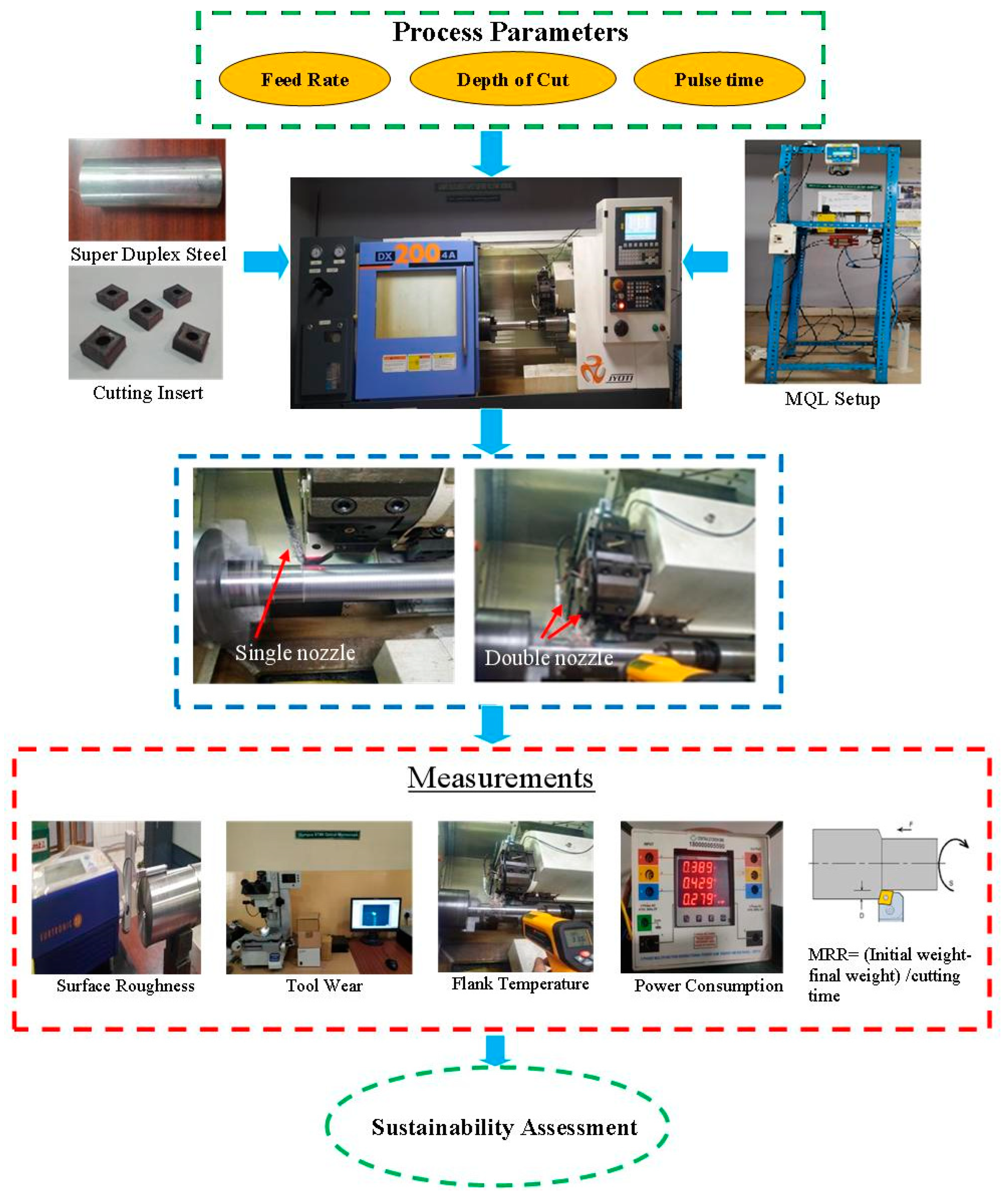
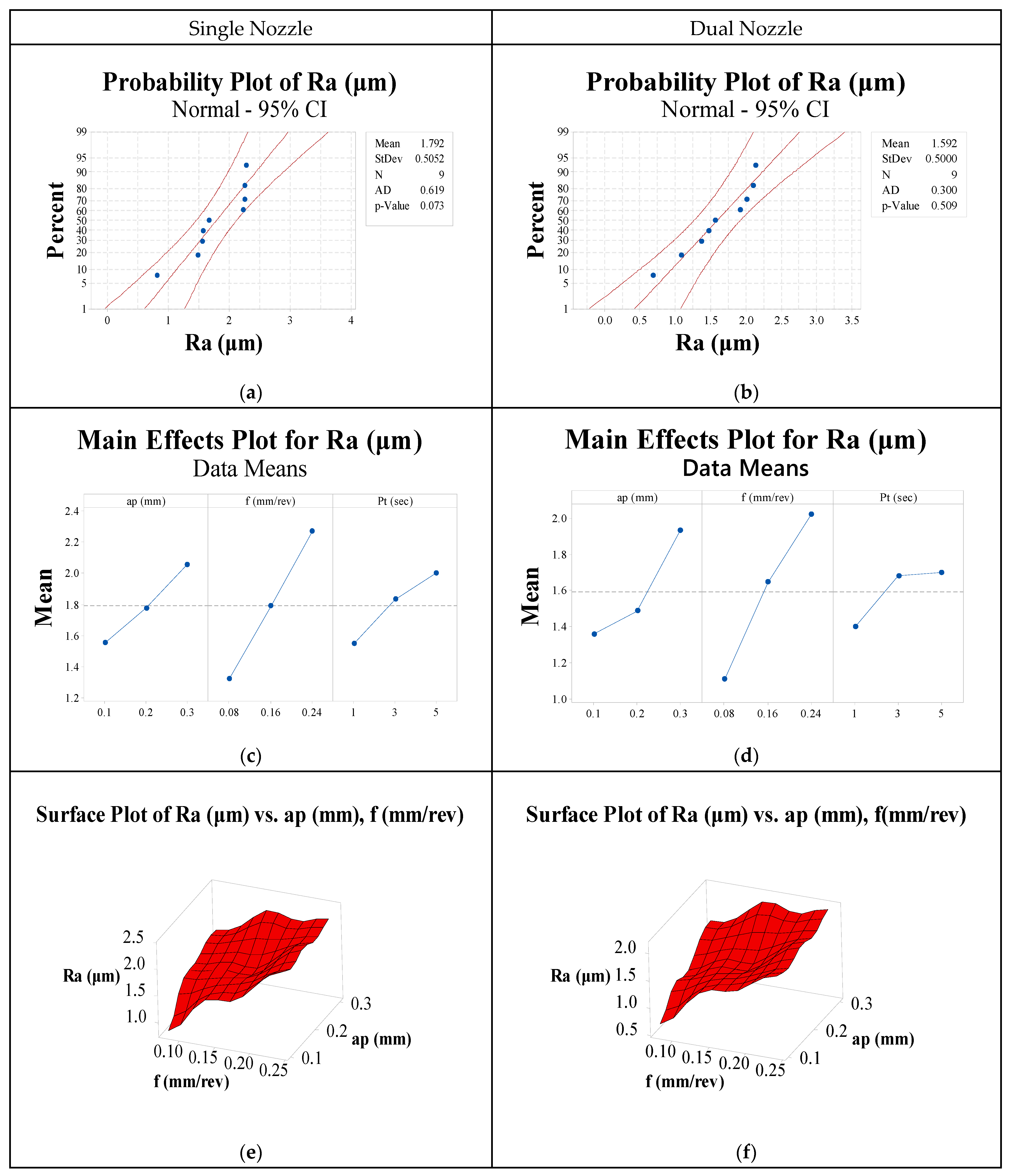

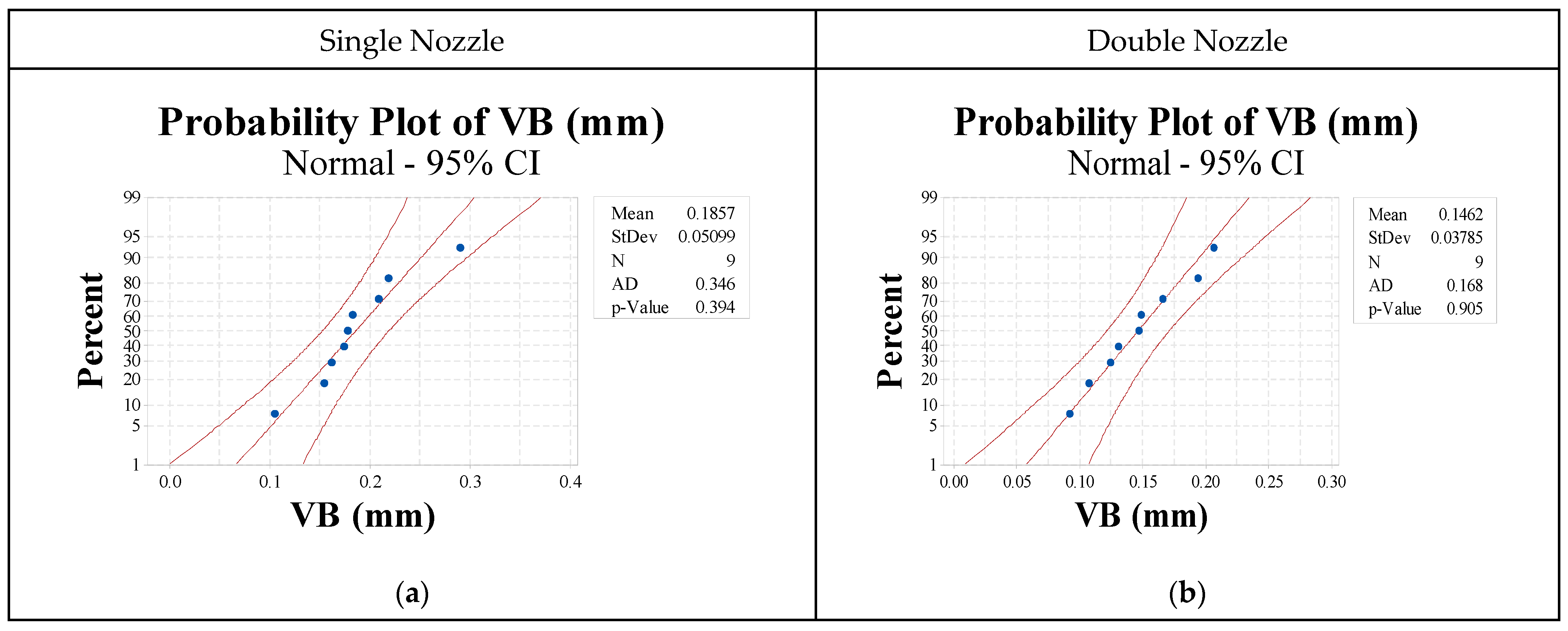

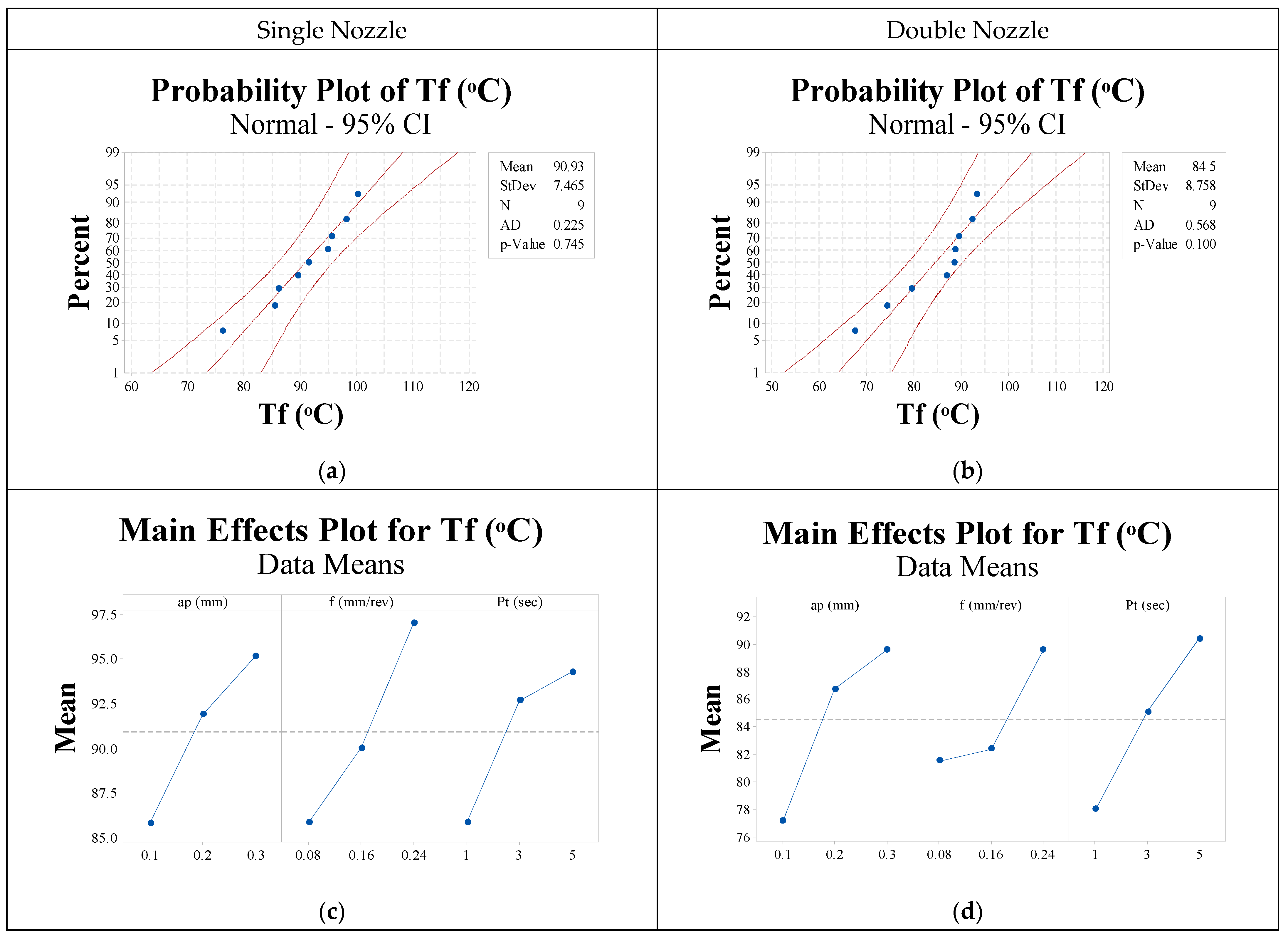
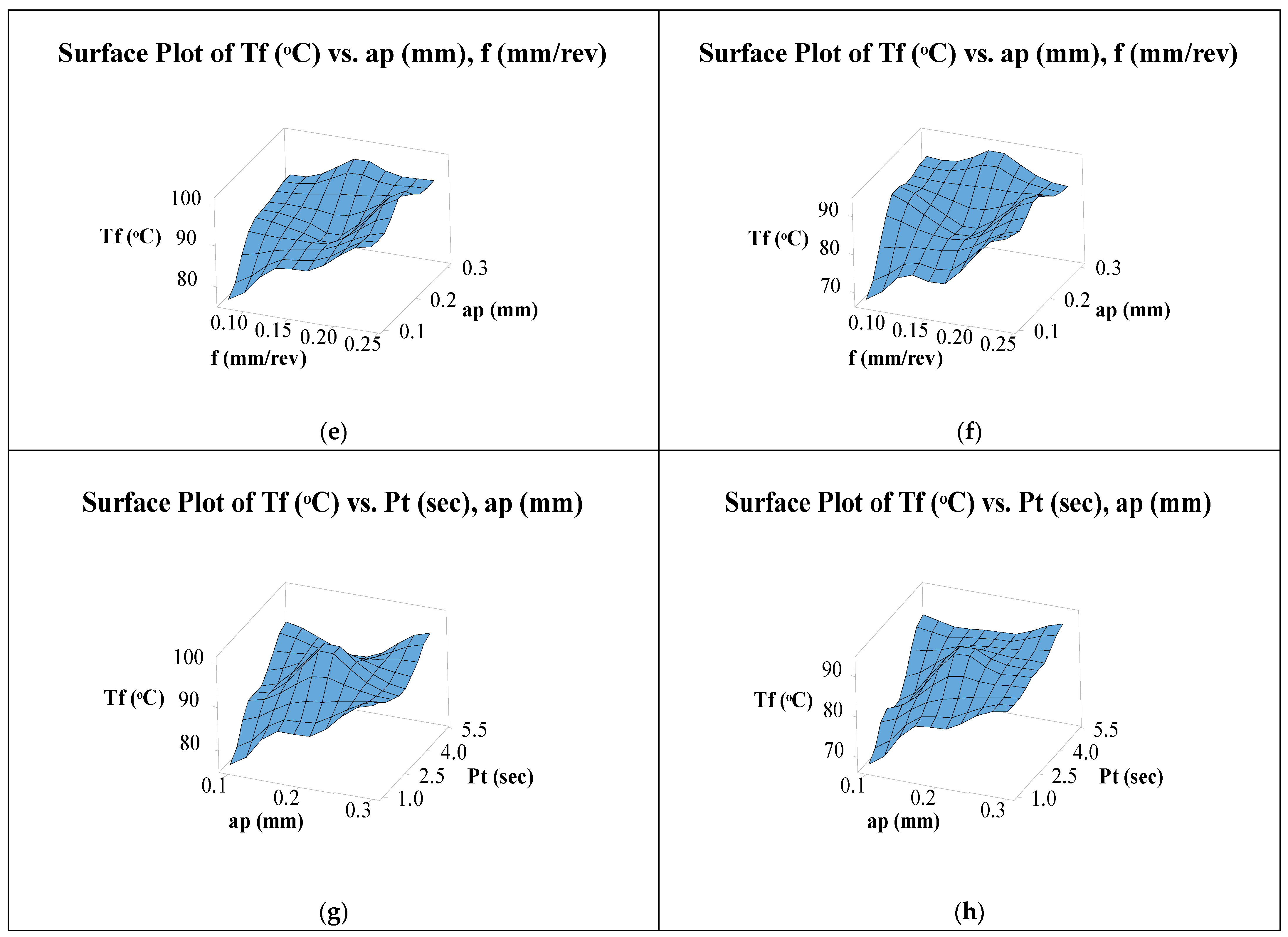

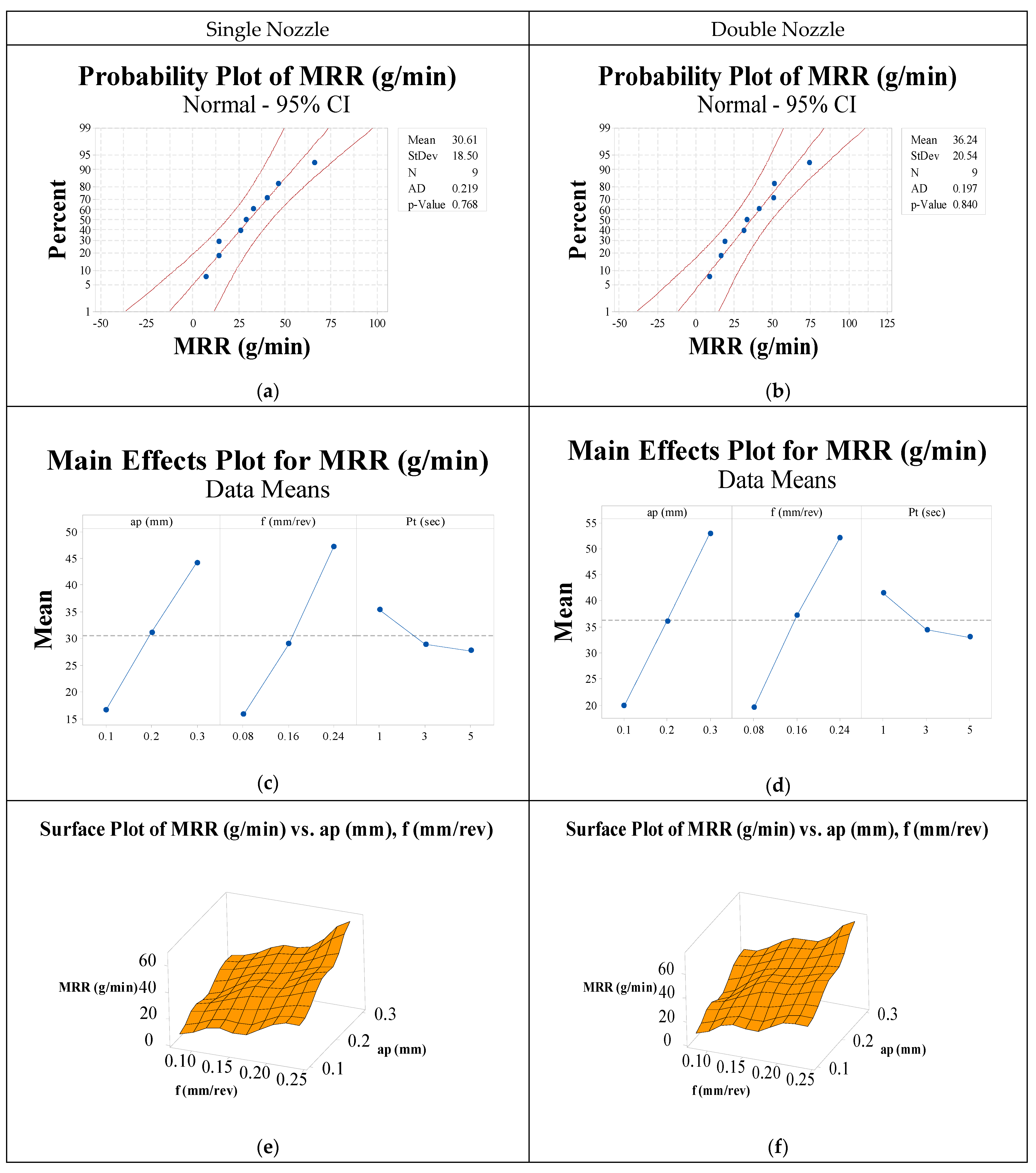
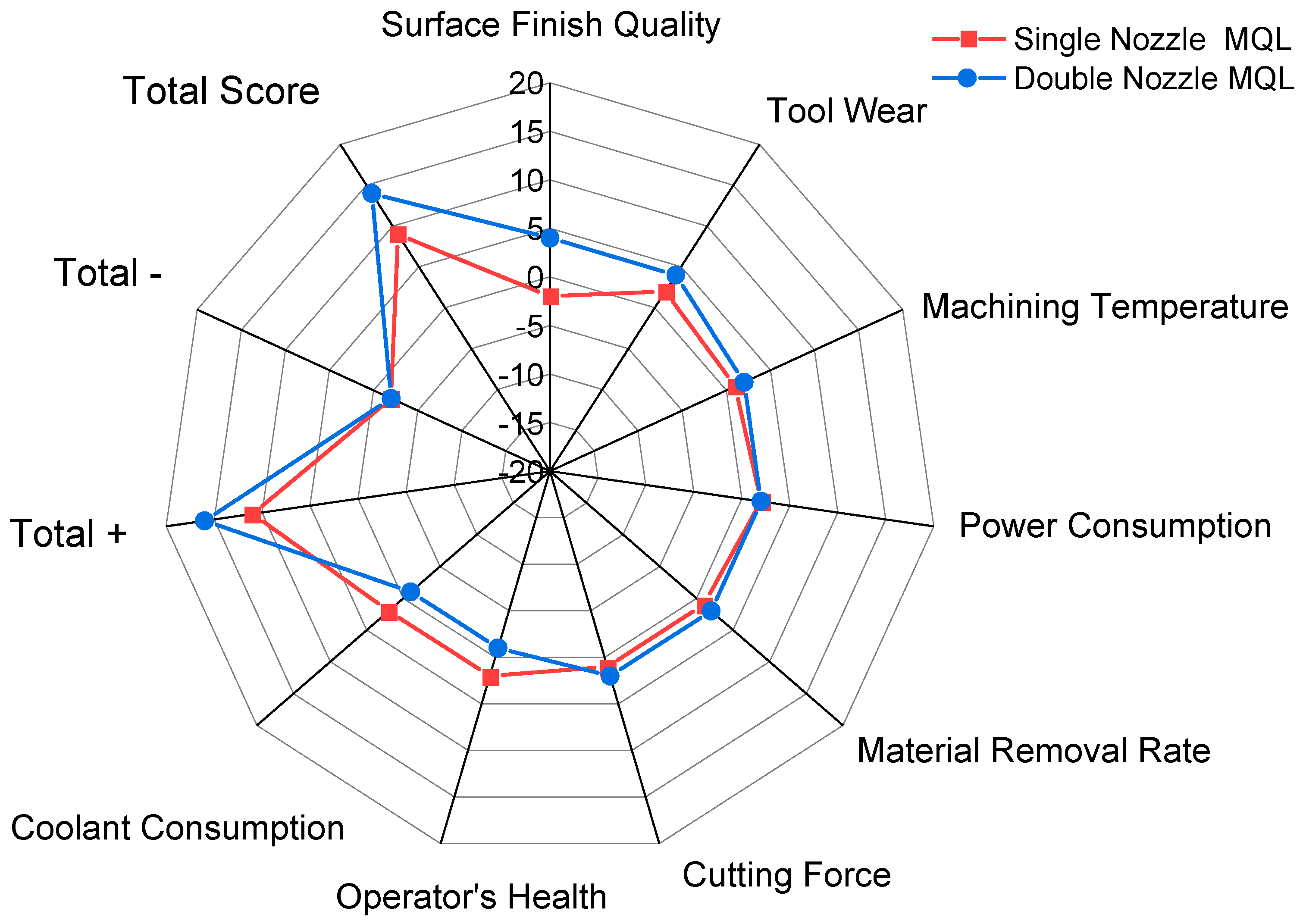
| Elements | Cr | Ni | Mo | Mn | Si | N | C | P | S | Fe |
|---|---|---|---|---|---|---|---|---|---|---|
| % Weight | 24.8 | 6.5 | 3.6 | 1.1 | 0.2 | 0.32 | 0.02 | 0.3 | 0.01 | balanced |
| Equipment/Items | Details |
|---|---|
| Turning Machine | CNC lathe machine model DX 200 4A |
| Work Specimen | UNS S32750 Super duplex stainless steel |
| Work Specimen Hardness | 27.2 HRC |
| Work Specimen Dimension | 200 mm in length and 60 mm in diameter |
| Cutting Length | 160 mm |
| Cutting Insert | CVD-coated carbide ISO Geometry: CNMG120404FF, tool geometry specification: clearance angle: 7°, rake angle: −6°, inclination angle: −6°, approach angle: 95°, nose radius: 0.4 mm Coating layers: TiN/TiCN/Al2O3/ZrCN |
| Cutting Insert Holder | PCLNR2525M12 |
| Machining Temperature Measurement Instrument | Portable infrared thermometer manufactured by Tashika Co., Ltd., Japan (Model TB-1350) |
| Design of the Experiment | Taguchi L9 orthogonal array |
| Machining Speed (V) | 100 m/min (Constant) |
| Feed Rate (f) | 0.08, 0.16, 0.24 mm/rev |
| Depth of Cut (ap) | 0.1, 0.2, 0.3 mm |
| Pulse Time (Pt) | 1, 3, 5 s |
| Spraying Nozzle Type | CH10 5/16 |
| MQL Lubricant Discharge Pressure | 6 bar |
| MQL Lubricant and Its Properties | LRT 30 oil Viscosity @ 30 °C = 47.6 cP Thermal conductivity @ 30 °C = 0.166 W/mK |
| Exp No. | Input Values | Output Results | ||||||
|---|---|---|---|---|---|---|---|---|
| ap (mm) | f (mm/rev) | Pt (s) | Ra (μm) | VB (mm) | Tf (°C) | Pc (kW) | MRR (g/min) | |
| Single-Nozzle MQL | ||||||||
| 1 | 0.1 | 0.08 | 1 | 0.81 | 0.105 | 76.3 | 0.756 | 7.10 |
| 2 | 0.1 | 0.16 | 3 | 1.56 | 0.154 | 86.2 | 0.803 | 13.93 |
| 3 | 0.1 | 0.24 | 5 | 2.28 | 0.209 | 94.9 | 0.891 | 28.81 |
| 4 | 0.2 | 0.08 | 5 | 1.49 | 0.178 | 89.7 | 0.867 | 14.11 |
| 5 | 0.2 | 0.16 | 1 | 1.57 | 0.161 | 85.6 | 0.889 | 32.74 |
| 6 | 0.2 | 0.24 | 3 | 2.26 | 0.174 | 100.3 | 0.924 | 46.51 |
| 7 | 0.3 | 0.08 | 3 | 1.67 | 0.182 | 91.5 | 0.872 | 26.06 |
| 8 | 0.3 | 0.16 | 5 | 2.23 | 0.290 | 98.2 | 0.967 | 40.10 |
| 9 | 0.3 | 0.24 | 1 | 2.26 | 0.218 | 95.7 | 1.012 | 66.15 |
| Double-Nozzle MQL | ||||||||
| 1 | 0.1 | 0.08 | 1 | 0.68 | 0.092 | 67.6 | 0.734 | 8.78 |
| 2 | 0.1 | 0.16 | 3 | 1.47 | 0.131 | 74.4 | 0.778 | 18.87 |
| 3 | 0.1 | 0.24 | 5 | 1.92 | 0.194 | 89.5 | 0.856 | 31.49 |
| 4 | 0.2 | 0.08 | 5 | 1.08 | 0.166 | 88.4 | 0.842 | 16.18 |
| 5 | 0.2 | 0.16 | 1 | 1.37 | 0.107 | 79.5 | 0.873 | 41.35 |
| 6 | 0.2 | 0.24 | 3 | 2.01 | 0.147 | 92.3 | 0.897 | 50.67 |
| 7 | 0.3 | 0.08 | 3 | 1.56 | 0.124 | 88.6 | 0.849 | 33.49 |
| 8 | 0.3 | 0.16 | 5 | 2.10 | 0.206 | 93.3 | 0.929 | 51.25 |
| 9 | 0.3 | 0.24 | 1 | 2.14 | 0.149 | 86.9 | 0.971 | 74.04 |
| Source | DF | Adj SS | Adj MS | F-Value | p-Value | % Contribution | Significant |
|---|---|---|---|---|---|---|---|
| Single Nozzle | |||||||
| ap | 2 | 0.38162 | 0.190811 | 37.09 | 0.026 | 18.69 | Yes |
| f | 2 | 1.33496 | 0.667478 | 129.75 | 0.008 | 65.39 | Yes |
| Pt | 2 | 0.31469 | 0.157344 | 30.59 | 0.032 | 15.41 | Yes |
| Error | 2 | 0.01029 | 0.005144 | ||||
| Total | 8 | 2.0415 | |||||
| Summary: R2 = 99.50%; R2 (adjacent) = 97.98%; R2 (prediction) = 89.79%. | |||||||
| Double Nozzle | |||||||
| ap | 2 | 0.54896 | 0.274478 | 126.04 | 0.008 | 27.45 | Yes |
| f | 2 | 1.27376 | 0.636878 | 292.44 | 0.003 | 63.70 | Yes |
| Pt | 2 | 0.17269 | 0.086344 | 39.65 | 0.025 | 8.64 | Yes |
| Error | 2 | 0.00436 | 0.002178 | ||||
| Total | 8 | 1.99976 | |||||
| Summary: R2 = 99.78%; R2 (adjacent) = 99.13%; R2 (prediction) = 95.59%. | |||||||
| Source | DF | Adj SS | Adj MS | F-Value | p-Value | % Contribution | Significant |
|---|---|---|---|---|---|---|---|
| Single Nozzle | |||||||
| ap | 2 | 0.009182 | 0.004591 | 126.36 | 0.008 | 44.14 | Yes |
| f | 2 | 0.004235 | 0.002117 | 58.28 | 0.017 | 20.35 | Yes |
| Pt | 2 | 0.007313 | 0.003656 | 100.63 | 0.010 | 35.16 | Yes |
| Error | 2 | 0.000073 | 0.000036 | ||||
| Total | 8 | 0.020802 | |||||
| Summary: R2 = 99.65%; R2 (adjacent) = 98.60%; R2 (prediction) = 92.93%. | |||||||
| Double Nozzle | |||||||
| ap | 2 | 0.000815 | 0.000407 | 8.71 | 0.103 | 7.11 | No |
| f | 2 | 0.001958 | 0.000979 | 20.93 | 0.046 | 17.09 | Yes |
| Pt | 2 | 0.008593 | 0.004296 | 91.85 | 0.011 | 74.98 | Yes |
| Error | 2 | 0.000094 | 0.000047 | ||||
| Total | 8 | 0.011460 | |||||
| Summary: R2 = 99.18%; R2 (adjacent) = 96.73%; R2 (prediction) = 83.47%. | |||||||
| Source | DF | Adj SS | Adj MS | F-Value | p-Value | % Contribution | Significant |
|---|---|---|---|---|---|---|---|
| Single Nozzle | |||||||
| Ap | 2 | 134.587 | 67.293 | 66.41 | 0.015 | 30.19 | Yes |
| f | 2 | 189.847 | 94.923 | 93.67 | 0.011 | 42.58 | Yes |
| Pt | 2 | 119.360 | 59.680 | 58.89 | 0.017 | 26.77 | Yes |
| Error | 2 | 2.027 | 1.013 | ||||
| Total | 8 | 445.820 | |||||
| Summary: R2 = 99.55%; R2 (adjacent) = 98.18%; R2 (prediction) = 90.79%. | |||||||
| Double Nozzle | |||||||
| ap | 2 | 254.33 | 127.163 | 24.35 | 0.039 | 41.44 | Yes |
| f | 2 | 116.65 | 58.323 | 11.17 | 0.082 | 19.01 | No |
| Pt | 2 | 232.26 | 116.130 | 22.23 | 0.043 | 37.85 | Yes |
| Error | 2 | 10.45 | 5.223 | ||||
| Total | 8 | 613.68 | |||||
| Summary: R2 = 98.30%; R2 (adjacent) = 93.19%; R2 (prediction) = 65.53%. | |||||||
| Source | DF | Adj SS | Adj MS | F-Value | p-Value | % Contribution | Significant |
|---|---|---|---|---|---|---|---|
| Single Nozzle | |||||||
| ap | 2 | 0.026994 | 0.013497 | 113.00 | 0.009 | 55.94 | Yes |
| f | 2 | 0.018372 | 0.009186 | 76.90 | 0.013 | 38.07 | Yes |
| Pt | 2 | 0.002652 | 0.001326 | 11.10 | 0.083 | 0.5 | No |
| Error | 2 | 0.000239 | 0.000119 | ||||
| Total | 8 | 0.048256 | |||||
| Summary: R2 = 99.50%; R2 (adjacent) = 98.02%; R2 (prediction) = 89.98%. | |||||||
| Double Nozzle | |||||||
| ap | 2 | 0.024830 | 0.012415 | 153.69 | 0.006 | 59.59 | Yes |
| f | 2 | 0.014907 | 0.007453 | 92.27 | 0.011 | 35.78 | Yes |
| Pt | 2 | 0.001770 | 0.000885 | 10.95 | 0.084 | 0.39 | No |
| Error | 2 | 0.000162 | 0.000081 | ||||
| Total | 8 | 0.041668 | |||||
| Summary: R2 = 99.6%; R2 (adjacent) = 98.45%; R2 (prediction) = 92.15%. | |||||||
| Source | DF | Adj SS | Adj MS | F-Value | p-Value | % Contribution | Significant |
|---|---|---|---|---|---|---|---|
| Single Nozzle | |||||||
| ap | 2 | 1134.71 | 567.355 | 126.49 | 0.008 | 41.45 | Yes |
| f | 2 | 1491.78 | 745.888 | 166.29 | 0.006 | 54.49 | Yes |
| Pt | 2 | 102.18 | 51.088 | 11.39 | 0.081 | 3.73 | Yes |
| Error | 2 | 8.97 | 4.485 | ||||
| Total | 8 | 2737.63 | |||||
| Summary: R2 = 99.67%; R2 (adjacent) = 98.69%; R2 (prediction) = 93.36%. | |||||||
| Double Nozzle | |||||||
| ap | 2 | 1654.82 | 827.408 | 508.19 | 0.002 | 49.00 | Yes |
| f | 2 | 1596.33 | 798.164 | 490.23 | 0.002 | 47.27 | Yes |
| Pt | 2 | 122.37 | 61.186 | 37.58 | 0.026 | 3.62 | No |
| Error | 2 | 3.26 | 1.628 | ||||
| Total | 8 | 3376.77 | |||||
| Summary: R2 = 99.90%; R2 (adjacent) = 99.61%; R2 (prediction) = 98.05%. | |||||||
| Sustainability Assessment Factors | Weight Factor | Single Nozzle MQL Score | Actual Score | Double Nozzle MQL Score | Actual Score |
|---|---|---|---|---|---|
| Surface Finish Quality | 2 W | −1 | −2 | +2 | +4 |
| Tool Wear | 2 W | +1 | +2 | +2 | +4 |
| Machining Temperature | 1 W | +1 | +1 | +2 | +2 |
| Power Consumption | 1 W | +2 | +2 | +2 | +2 |
| Material Removal Rate | 1 W | +1 | +1 | +2 | +2 |
| Cutting Force | 1 W | +1 | +1 | +2 | +2 |
| Operator’s Health | 1 W | +2 | +2 | −1 | −1 |
| Lubricant Consumption | 1 W | +2 | +2 | −1 | −1 |
| Total + | +10 | +11 | +12 | +16 | |
| Total − | −1 | −2 | −2 | −2 | |
| Total Score | +9 | +9 | +10 | +14 |
Disclaimer/Publisher’s Note: The statements, opinions and data contained in all publications are solely those of the individual author(s) and contributor(s) and not of MDPI and/or the editor(s). MDPI and/or the editor(s) disclaim responsibility for any injury to people or property resulting from any ideas, methods, instructions or products referred to in the content. |
© 2023 by the authors. Licensee MDPI, Basel, Switzerland. This article is an open access article distributed under the terms and conditions of the Creative Commons Attribution (CC BY) license (https://creativecommons.org/licenses/by/4.0/).
Share and Cite
Roy, S.; Kumar, R.; Panda, A.; Sahoo, A.K.; Rafighi, M.; Das, D. A Comparative Performance Investigation of Single- and Double-Nozzle Pulse Mode Minimum Quantity Lubrication Systems in Turning Super-Duplex Steel Using a Weighted Pugh Matrix Sustainable Approach. Sustainability 2023, 15, 15160. https://doi.org/10.3390/su152015160
Roy S, Kumar R, Panda A, Sahoo AK, Rafighi M, Das D. A Comparative Performance Investigation of Single- and Double-Nozzle Pulse Mode Minimum Quantity Lubrication Systems in Turning Super-Duplex Steel Using a Weighted Pugh Matrix Sustainable Approach. Sustainability. 2023; 15(20):15160. https://doi.org/10.3390/su152015160
Chicago/Turabian StyleRoy, Soumikh, Ramanuj Kumar, Amlana Panda, Ashok Kumar Sahoo, Mohammad Rafighi, and Diptikanta Das. 2023. "A Comparative Performance Investigation of Single- and Double-Nozzle Pulse Mode Minimum Quantity Lubrication Systems in Turning Super-Duplex Steel Using a Weighted Pugh Matrix Sustainable Approach" Sustainability 15, no. 20: 15160. https://doi.org/10.3390/su152015160
APA StyleRoy, S., Kumar, R., Panda, A., Sahoo, A. K., Rafighi, M., & Das, D. (2023). A Comparative Performance Investigation of Single- and Double-Nozzle Pulse Mode Minimum Quantity Lubrication Systems in Turning Super-Duplex Steel Using a Weighted Pugh Matrix Sustainable Approach. Sustainability, 15(20), 15160. https://doi.org/10.3390/su152015160













